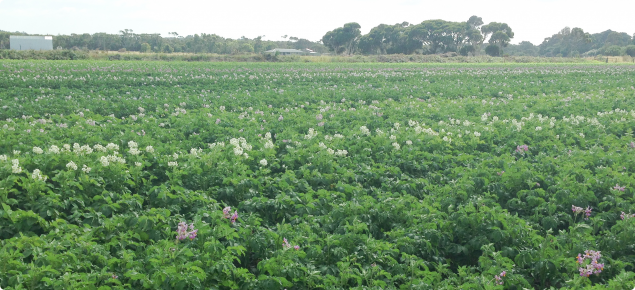In Western Australia, as part of the seed potato certification scheme, leaves from Generation 2 seed potato crops are sampled late in the growing season. The leaves are tested in the laboratory for PLRV and four other viruses using enzyme-linked immunosorbent assay (ELISA) or polymerase chain reaction (PCR) .
From 2005 to 2015 the level of PLRV detected in the Generation 2 seed potato crops ranged from 0 to 0.5% of total potato plants tested. In 2015 no PLRV was found in the G2 seed potato crop survey, but growers need to remain vigilant to contain this disease to low levels.
Infection
Initial infection of potato crops by PLRV occurs when plants become infected by virus-carrying aphids during the growing season (primary infection). Infection also occurs when seed stocks containing infected tubers are planted, and infected potato plants grow from them (secondary infection). Aphids then spread the infection further.
All tubers produced from an infected plant will carry the virus, so when they sprout the plant is already infected and can act as a virus source to neighbouring plants.
Symptoms
Symptoms of primary infection are visible in the young leaves with upward rolling of the leaf margins. This occurs mainly in the part of the leaf near the base. The affected leaves are slightly pale and may show purpling or reddening. The leaves are often crunchy when touched.
Symptoms of secondary infection are visible on all leaves, with upward rolling of lower leaves, while young leaves are often upright and pale. Lower leaves are stiff and crunchy when touched and often have purpled or reddened undersides (Figure 1). Infected plants are usually stunted (Figure 2).
Visible symptoms vary with the age at which the plant becomes infected, the variety, environmental conditions and crop vigour.
Recently in some varieties there have been instances where visual foliage symptoms are subtle or not expressed in infected plants. This is a serious issue as it can lead to virus infection being missed in visual inspections of seed potato or ware crops. This can then lead to crops having unacceptably high levels of PLRV.
Although such symptoms may be subtle or invisible, these apparently healthy plants can act as sources of the virus for spread by aphids to nearby plants. The seed tubers they produce will carry the virus providing infection sources for subsequent crops. The cause of the poor symptom expression is not known.
Depending on the variety, PLRV-infected plants produce few and smaller tubers, and ‘russet’ varieties sometimes show internal browning that affects marketable yield.

